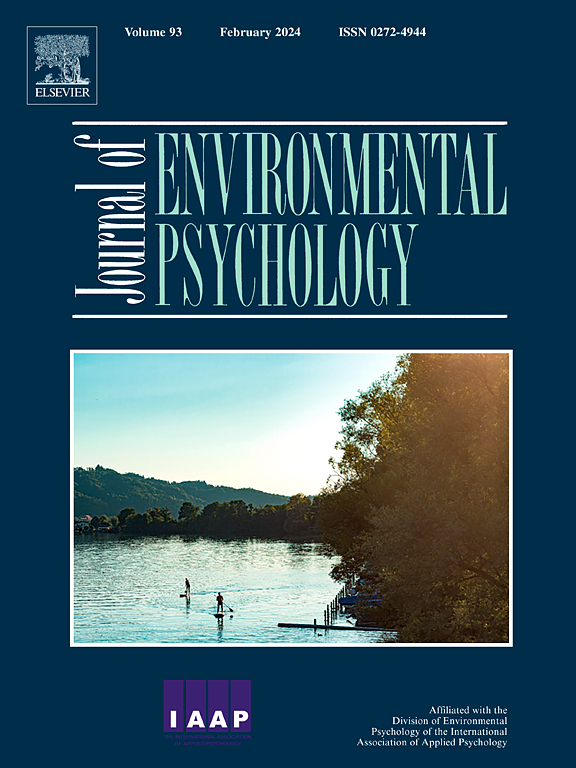Living closer to the beach is associated with better socioemotional development in young boys
IF 6.1
1区 心理学
Q1 ENVIRONMENTAL STUDIES
引用次数: 0
Abstract
Background
Natural outdoor environments such as green and blue spaces have increasingly been seen as key health and wellbeing determinants for adults. However, it is unclear if these effects are seen in young children. We examined the associations between access to natural green and blue space and young children's socioemotional development.
Methods
Cross-sectional baseline data for 1525 young children (median age 3.3 years) in the PLAYCE cohort study were examined. The parent-report Strengths and Difficulties Questionnaire (SDQ) total difficulties score was used as a measure of socioemotional development. High-resolution aerial imagery and Geographic Information Systems were used to identify total percentage of neighbourhood vegetation and vegetation components (grass, shrubs, and trees) and total percentage of blue space (ocean, riverways and lakes and swamps) for 1600m network service areas and 5000m buffer areas around children's residences. Road network distance to the closest beach, patrolled beach and dog beach were also calculated. Multiple linear regression analyses were used to examine the associations between green and blue space variables and children's total difficulties score, adjusting for covariates.
Results
Several associations were observed amongst young boys' socioemotional development and distance to the closest beach and patrolled beach, with boys’ socioemotional development improving with decreasing distance to the beach even after adjusting for neighbourhood socioeconomic status. No significant associations were found between the amount of neighbourhood blue space or vegetation within the 1600m or 5000m service area and preschooler social and emotional development.
Conclusions
These findings highlight the potential benefit of living closer to a beach for socioemotional development, particularly for young boys. Our findings have implications for urban planning in terms of the need for improved access to beaches and the protection of natural environments to support young children's development.
求助全文
约1分钟内获得全文
求助全文
来源期刊

Journal of Environmental Psychology
Multiple-
CiteScore
10.60
自引率
8.70%
发文量
140
审稿时长
62 days
期刊介绍:
The Journal of Environmental Psychology is the premier journal in the field, serving individuals in a wide range of disciplines who have an interest in the scientific study of the transactions and interrelationships between people and their surroundings (including built, social, natural and virtual environments, the use and abuse of nature and natural resources, and sustainability-related behavior). The journal publishes internationally contributed empirical studies and reviews of research on these topics that advance new insights. As an important forum for the field, the journal publishes some of the most influential papers in the discipline that reflect the scientific development of environmental psychology. Contributions on theoretical, methodological, and practical aspects of all human-environment interactions are welcome, along with innovative or interdisciplinary approaches that have a psychological emphasis. Research areas include: •Psychological and behavioral aspects of people and nature •Cognitive mapping, spatial cognition and wayfinding •Ecological consequences of human actions •Theories of place, place attachment, and place identity •Environmental risks and hazards: perception, behavior, and management •Perception and evaluation of buildings and natural landscapes •Effects of physical and natural settings on human cognition and health •Theories of proenvironmental behavior, norms, attitudes, and personality •Psychology of sustainability and climate change •Psychological aspects of resource management and crises •Social use of space: crowding, privacy, territoriality, personal space •Design of, and experiences related to, the physical aspects of workplaces, schools, residences, public buildings and public space
 求助内容:
求助内容: 应助结果提醒方式:
应助结果提醒方式:


